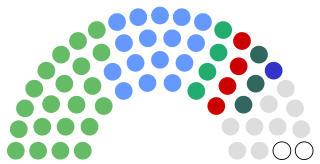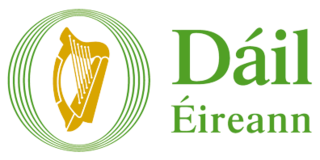
The Oireachtas, sometimes referred to as Oireachtas Éireann, is the bicameral parliament of Ireland. The Oireachtas consists of the President of Ireland and the two houses of the Oireachtas, the Dáil Éireann and the Seanad Éireann.

Cathaoirleach is the title of the chair of Seanad Éireann, the sixty-member upper house of the Oireachtas, the legislature of Ireland. The current Cathaoirleach is Fine Gael Senator Jerry Buttimer, who has held the office since 16 December 2022.

The Constitution of Ireland is the fundamental law of Ireland. It asserts the national sovereignty of the Irish people. The constitution, based on a system of representative democracy, is broadly within the tradition of liberal democracy. It guarantees certain fundamental rights, along with a popularly elected non-executive president, a bicameral parliament, a separation of powers and judicial review.
The Second Dáil was Dáil Éireann as it convened from 16 August 1921 until 8 June 1922. From 1919 to 1922, Dáil Éireann was the revolutionary parliament of the self-proclaimed Irish Republic. The Second Dáil consisted of members elected at the 1921 elections, but with only members of Sinn Féin taking their seats. On 7 January 1922, it ratified the Anglo-Irish Treaty by 64 votes to 57 which ended the War of Independence and led to the establishment of the Irish Free State on 6 December 1922.

The Constitution of the Irish Free State was adopted by Act of Dáil Éireann sitting as a constituent assembly on 25 October 1922. In accordance with Article 83 of the Constitution, the Irish Free State Constitution Act 1922 of the British Parliament, which came into effect upon receiving the royal assent on 5 December 1922, provided that the Constitution would come into effect upon the issue of a Royal Proclamation, which was done on 6 December 1922. In 1937 the Constitution of the Irish Free State was replaced by the modern Constitution of Ireland following a referendum.
A bill is a proposal for a new law, or a proposal to significantly change an existing law. A bill does not become law until it is passed by the legislature and has been, in most cases, approved by the executive. Once a bill has been enacted into law by the legislature, it is called an act of the legislature, or a statute. Bills are introduced in the legislature and are discussed, debated and voted upon.

Dáil Éireann served as the directly elected lower house of the Oireachtas of the Irish Free State from 1922 to 1937. The Free State constitution described the role of the house as that of a "Chamber of Deputies". Until 1936 the Free State Oireachtas also included an upper house known as the Seanad. Like its modern successor, the Free State Dáil was, in any case, the dominant component of the legislature; it effectively had authority to enact almost any law it chose, and to appoint and dismiss the President of the Executive Council. The Free State Dáil ceased to be with the creation of the modern 'Dáil Éireann' under the terms of the 1937 Constitution of Ireland. Both the Dáil and Seanad sat in Leinster House.

The Oireachtas of the Irish Free State was the legislature of the Irish Free State from 1922 until 1937. It was established by the 1922 Constitution of Ireland which was based from the Anglo-Irish Treaty. It was the first independent Irish Parliament officially recognised outside Ireland since the historic Parliament of Ireland which was abolished with the Acts of Union 1800.
The parliament of the Republic of Ireland is the Oireachtas.

The current Constitution of Ireland came into effect on 29 December 1937, repealing and replacing the Constitution of the Irish Free State, having been approved in a national plebiscite on 1 July 1937 with the support of 56.5% of voters in the then Irish Free State. The Constitution was closely associated with Éamon de Valera, the President of the Executive Council of the Irish Free State at the time of its approval.
The 4th Dáil was elected at the 1923 general election on 27 August 1923 and met on 19 September 1923. The members of Dáil Éireann, the house of representatives of the Oireachtas (legislature) of the Irish Free State, are known as TDs. The 4th Dáil lasted 1,343 days. Although Cumann na nGaedheal did not have a majority it was able to govern due to the absence of Republicans who refused to attend. The 4th Dáil was dissolved by Governor-General Tim Healy on 23 May 1927, at the request of the President of the Executive Council W. T. Cosgrave.
The 5th Dáil was elected at the June 1927 general election on 9 June 1927 and met on 23 June 1927. The members of Dáil Éireann, the house of representatives of the Oireachtas (legislature) of the Irish Free State, are known as TDs. The 5th Dáil was dissolved on 25 August 1927 by Governor-General Tim Healy, at the advice of the President of the Executive Council W. T. Cosgrave. The 5th Dáil is the shortest Dáil in the history of the state, lasting only 64 days.
The 8th Dáil was elected at the 1933 general election on 24 January 1933 and met on 8 February 1933. The members of Dáil Éireann, the house of representatives of the Oireachtas (legislature) of the Irish Free State, are known as TDs. From 29 May 1936, it was the sole house of the Oireachtas, after the disbandment of Seanad Éireann. The 8th Dáil was dissolved on 14 June 1937. The 8th Dáil lasted 1,588 days.
The 9th Dáil was elected at the 1937 general election on 1 July 1937 and met on 21 July 1937. The members of Dáil Éireann, the house of representatives of the Oireachtas (legislature) of the Irish Free State, are known as TDs. Seanad Éireann, a second chamber in the Irish Free State, had been abolished in May 1936.
In modern competitive Irish dance, an oireachtas refers to an annual championship competition. Oireachtais are held by several Irish dance organisations globally, including An Coimisiún Le Rincí Gaelacha, An Comhdhail na Múinteoirí le Rincí Gaelacha, the World Irish Dance Association, and others. Many oireachtais include both solo and ceilí (team) events. The competitions vary in size, duration, and level of eligibility.

Seanad Éireann is the upper house of the Oireachtas, which also comprises the President of Ireland and Dáil Éireann.
The 1934 Seanad was the part of the Seanad of the Irish Free State (1922–1936) in office after the 1934 Seanad election until its abolition in 1936. Elections to the Seanad, the Senate of the Oireachtas took place on a triennial basis, with senators elected in stages. The 1934 Seanad included members elected at the 1925, 1928, 1931 and 1934 Seanad elections. It sat as a second chamber to the 8th Dáil elected at the 1933 general election.
Aengus Mac Grianna is a former Irish newsreader for RTÉ. Mac Grianna was born in Raheny, a suburb in north Dublin, to an Irish-speaking family. His father was a scientist and his mother was a teacher. Mac Grianna was educated solely through Irish. He broadcast in both Irish and English. Mac Grianna has presented the Oireachtas Media Awards. He lives on an alpaca farm in County Meath just outside Ashbourne with his husband Terry Gill whom he married in June 2014. His first job was in the Arnotts Sports Department where he earned £80 per week. He is a fan of Desperate Housewives and Coronation Street and supports Dublin and Manchester United. Mac Grianna was considered a favourite to replace iconic newsreader Anne Doyle when she retired on 25 December 2011.
The Senate of Ireland is the current upper house of the Oireachtas.

Dáil Éireann is the lower house, and principal chamber, of the Oireachtas, which also includes the President of Ireland and Seanad Éireann. It consists of 160 members, each known as a Teachta Dála. TDs represent 39 constituencies and are directly elected for terms not exceeding five years, on the system of proportional representation by means of the single transferable vote (PR-STV). Its powers are similar to those of lower houses under many other bicameral parliamentary systems and it is by far the dominant branch of the Oireachtas. Subject to the limits imposed by the Constitution of Ireland, it has power to pass any law it wishes, and to nominate and remove the Taoiseach. Since 1922, it has met in Leinster House in Dublin.






